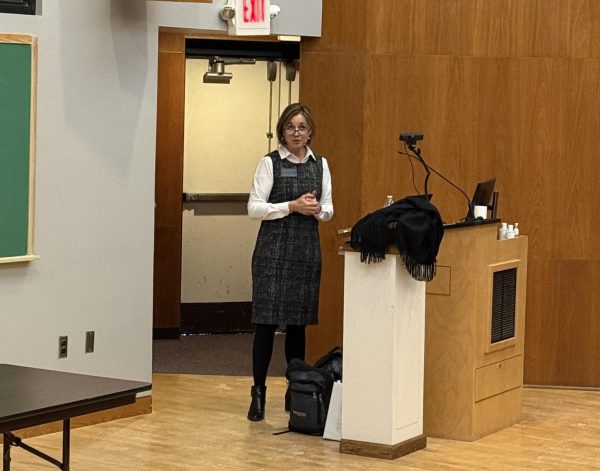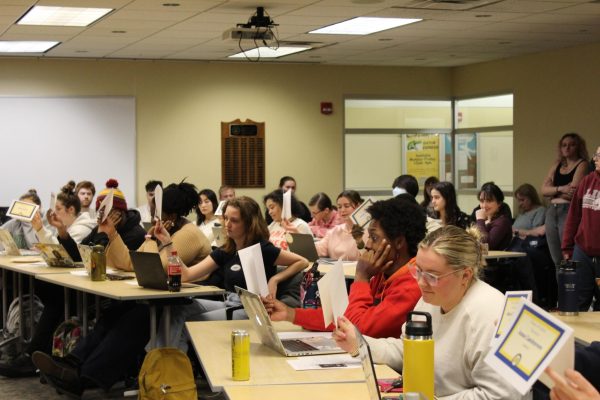Science Cafe hosts panel on COVID-19 and vaccines
The second Science Cafe of the year was held on March 18 covering COVID-19 and vaccine information. Biology Chair and Professor of Biochemistry Tricia Humphreys and Professor of Biology and Global Health Studies Becky Dawson, both current members of the Allegheny College Health Agency, were guest speakers on the panel.
The event was sponsored by Sigma Xi, an international regionally chapter based health organization that seeks to “enhance the health of the scientific enterprise by fostering the integrity in science and health engineering and promote the public’s understanding of science.”
The presentation began with preliminary information about virus structures. The general make-up of a virus includes a protein coat and the genetic material inside of the protein coat. Coronaviruses have RNA genetic material, as opposed to DNA in other virus types. The outer extremities of the virus are known as spike proteins, which explain the shape of COVID-19.
Dawson discussed vaccine development, explaining the testing process and the expediency of development for the COVID-19 vaccines.
“Preclinical work, pre-human being, will move to a mouse or rodent model,” Dawson said. “The immune response is quantified. Sometimes we use primates to do this preclinical work.”
After this preclinical testing, the results are submitted to the Food and Drug Administration, to gain approval for clinical trials. There are three stages of clinical trials that must be passed before it can be distributed.
“Phase one looks at the safety of the vaccine by putting the vaccine into a small group of people’s bodies.” Dawson said. “You can then monitor those severe adverse effects before you can start moving into larger groups. As you move into phase two you begin looking at safety, as that continues to be the important thing.”
Dawson noted that safety is considered throughout the process, explaining that avoiding adverse effects — like anaphylactic shock — is a priority. In addition, she expressed that vaccine developers closely monitor whether or not there is evidence that the vaccine could potentially amplify the effects of the virus it is seeking to cure.
“Phase three is the randomized control part,” Dawson said. “That is where a lot of people, 30-to-40 thousand people, random sampling of half of the people get the vaccine and the other half get the placebo. This is where immune response (and) hospitalization (is being studied). After this, the results are submitted to the FDA for approval.”
SARs and MERs are very similar, as a result this has been a contributing factor for the rapid development of the COVID-19 vaccine. MRNA, which is genetic manipulation has also contributed to the expediency of the development of the vaccination.
“No steps were skipped or exempted, but things moved really fast,” Dawson said. “The FDA did rolling reviews of data.”
Funding from the federal government also aided the quick development and distribution of COVID-19 vaccines even prior to the approval of the FDA. This was a financial risk, that the vaccine may not work or be approved for use, however this backing padded the development of the vaccines so the various pharmaceutical companies did not have to fund the development entirely in-house. Once approved by the FDA, the vaccines began being distributed within 24 hours.
All information regarding the development of COVID-19 vaccines is publicly available, according to the panelists. Dawson emphasized that no steps in development were skipped, but rather expedited.
Humphreys explained the platforms for two vaccines that have been approved for emergency use.
“Moderna utilizes nanoparticles with messenger RNA that translates into spike particles in the immune system,” Humphreys said. “Johnson and Johnson had a similar concept, by taking the coding region for the spike protein, and putting this code into an adenovirus. This code will enter into cells and the spike protein will be put into the immune system.”
Humphreys further explained how both of these vaccines utilize the spike protein.
“The spike protein has been changing, some of the changes have been silent,” Humphreys said. “That means that they do not actually change the protein, even though the MRNA sequence has changed, some of those sequences have brought changes in amino proteins.”
The vaccine cannot account for all of the mutations within the virus, according to Humphreys, who noted that “some variations are bound to slip through.” The decision to code the spikes of the virus into the immune system is an attempt to account for as many variations as possible.
Dawson noted that the Pfizer, Astrazeneca, Johnson and Johnson, and Moderna vaccine platforms are effective at preventing death and illness. The panel members expressed that the at-risk groups must remain prioritized, so as to not bog down the medical system.
Vaccinated individuals are now beginning to congregate without masks safely. The panelists described the day following 14 days after the vaccination is administered as a “vaxxiversary.” This means that the recipient is now fully vaccinated and is able to celebrate with other vaccinated individuals. Precautions should continue to be taken with non-vaccinated individuals, the panelists noted, but collection within vaccinated groups is almost entirely safe.








